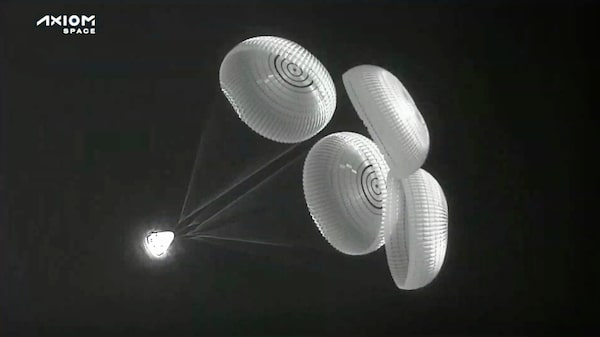
The Dragon space capsule uses parachutes as it descends to the Atlantic Ocean off the Florida coast on April 25.The Associated Press
The first all-private astronaut team ever flown aboard the International Space Station (ISS) safely splashed down in the Atlantic off Florida’s coast on Monday, concluding a two-week science mission hailed as a landmark in commercialized human spaceflight.
The SpaceX crew capsule carrying the four-man team, led by a retired NASA astronaut who is now vice president of the Texas company behind the mission, Axiom Space, parachuted into the sea after a 16-hour descent from orbit.
The splashdown capped the latest, and most ambitious, in a recent series of rocket-powered expeditions bankrolled by private investment capital and wealthy passengers rather than taxpayer dollars six decades after the dawn of the space age.
The mission’s crew was assembled, equipped and trained entirely at private expense by Axiom, a 5-year-old venture based in Houston and headed by NASA’s former ISS program manager. Axiom also has contracted with NASA to build the first commercial addition to and ultimate replacement for the space station.
SpaceX, the launch service founded by Tesla Inc electric carmaker CEO Elon Musk, supplied the Falcon 9 rocket and Crew Dragon capsule that carried Axiom’s team to and from orbit, controlled the flight and handled the splashdown recovery.
NASA, which has encouraged the further commercialization of space travel, furnished the launch site at its Kennedy Space Center in Cape Canaveral, Florida, and assumed responsibility for the Axiom crew while they were aboard the space station. The U.S. space agency’s ISS crew members also pitched in to assist the private astronauts when needed.
The multinational Axiom team was led by Spanish-born retired NASA astronaut Michael Lopez-Alegria, 63, the company’s vice president for business development. His second-in-command was Larry Connor, 72, a technology entrepreneur and aerobatics aviator from Ohio designated the mission pilot.
Joining them as “mission specialists” were investor-philanthropist and former Israeli fighter pilot Eytan Stibbe, 64, and Canadian businessman and philanthropist Mark Pathy, 52.
Connor, Stibbe and Pathy flew as customers of Axiom, which charges $50 million to $60 million per seat for such flights, according to Mo Islam, head of research for the investment firm Republic Capital, which holds stakes in both Axiom and SpaceX.
The splashdown, carried live by a joint Axiom-SpaceX webcast, was originally planned for last Wednesday, but the return flight was delayed due to unfavorable weather.
The return from orbit followed a re-entry plunge through Earth’s atmosphere generating frictional heat that sends temperatures surrounding the outside of the capsule soaring to 3,500 degrees Fahrenheit 1,927 degrees Celsius).
Applause was heard from the SpaceX flight control center in suburban Los Angeles as parachutes billowed open above the capsule in the final stage of its descent - slowing its fall to about 15 miles per hour (24 kph) - and again as the craft hit the water off the coast of Jacksonville.
In less than an hour, the heat-scorched Crew Dragon was hoisted onto a recovery ship before the capsule’s side hatch was opened and the four astronauts, garbed in helmeted white-and-black spacesuits, were helped out one by one onto the deck. All were visibly unsteady on their feet from more than two weeks spent in a weightless environment.
Each stood on the deck a few moments in front of the capsule to pose for pictures before being escorted to an onboard medical facility for a routine checkup.
Axiom, SpaceX and NASA have touted the occasion as a milestone in the expansion of privately funded space-based commerce, constituting what industry insiders call the “low-Earth orbit economy,” or “LEO economy” for short.
Launched on April 8, the Axiom team spent 15 days aboard the space station with the seven regular, government-paid ISS crew members: three American astronauts, a German astronaut and three Russian cosmonauts.
The ISS has hosted several wealthy space tourists from time to time over the years.
But the Axiom quartet was the first all-commercial team ever welcomed to the space station as working astronauts, bringing with them 25 science and biomedical experiments to conduct in orbit. The package included research on brain health, cardiac stem cells, cancer and aging, as well as a technology demonstration to produce optics using the surface tension of fluids in microgravity.
It was the sixth human spaceflight for SpaceX in nearly two years, following four NASA astronaut missions to the ISS and the “Inspiration 4″ flight in September that sent an all-private crew into Earth orbit for the first time, though not to the space station.
SpaceX has been hired to fly three more Axiom astronaut missions to ISS over the next two years.
Our Morning Update and Evening Update newsletters are written by Globe editors, giving you a concise summary of the day’s most important headlines. Sign up today.